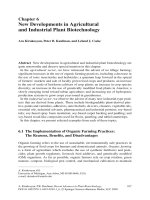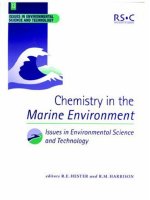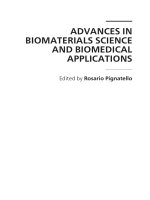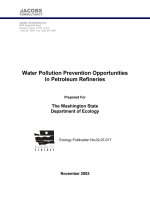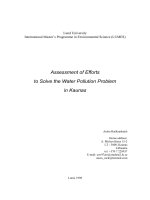paraffin products developments in petroleum science
Bạn đang xem bản rút gọn của tài liệu. Xem và tải ngay bản đầy đủ của tài liệu tại đây (16.1 MB, 337 trang )
Der&qmients
in
Petroleum
Science,
14
P
araffin
products
Prapedcs,
rech
plloivggit?,~,
appliuu
iiot
1s
FURTHER TITLES
IN
THIS
SERIES
1
A. GENE COLLINS
GEOCHEMISTRY OF OILFIELD WATERS
2
W. H. FERTL
ABNORMAL FORMATION PRESSURES
3
A.P. SZILAS
PRODUCTION AND TRANSPORT OF OIL AND GAS
4
C.E.B. CONYBEARE
GEOMORPHOLOGY OF OIL AND GAS FIELDS
IN SANDSTONE BODIES
5
T.F. YEN and G.V. CHILINGARIAN (Editors)
OIL SHALE
6
D.W. PEACEMAN
FUNDAMENTALS OF NUMERICAL RESERVOIR SIMULATION
7 G.V. CHILINGARIAN and T.F. YEN (Editors)
BITUMENS, ASPHALTS AND TAR SANDS
8
L.P. DAKE
FUNDAMENTALS OF RESERVOIR ENGINEERING
9
K.
MAGARA
COMPACTION AND FLUID MIGRATION
10
M.T. SILVIA and E.A. ROBINSON
DECONVOLUTION OF GEOPHYSICAL TIME SERIES IN THE
EXPLORATION FOR OIL AND NATURAL GAS
11
G.V. CHILINGARIAN
and
P. VORABUTR
DRILLING AND DRILLING FLUIDS
12
T. VAN GOLF-RACHT
FRACTURED HYDROCARBON-RESERVOIR ENGINEERING
13
F. JOHN FAYERS (Editor)
ENHANCED OIL RECOVERY
Developments in Petroleum Science,
14
P
araffin
products
Properties,
technologies, applications
by
M. FREUND
Member
of
the Hungarian
Academy
of
Sciences
R.
CSIKdS
Hungarian
Oil
and Gas
Research Institute
S.
KESZTHELYI
Hungarian Oil and Gas
Research Institute
GY.
M6ZES
ffungarian
Oil
and
Gas
Research Institute
edited
by
GY.
M6ZES
ELSEVIER
SCIENTIFIC PUBLISHING COMPANY
AMSTERDAM -OXFORD
-
NEW
YORK
1982
Joint edition published by
Elsevier Scientific Publishing Company, Amsterdam, The Netherlands and
Akadkmiai Kiadb, The Publishing House
of
the Hungarian Academy
of
Sciences,
Budapest, Hungary
Revised and updated translation
of
‘Kaolaj paraffinok’
published by Milszaki Konyvkiadb,
Budapest
Translated
by
E.
JAKAB
The distribution
of
this book is being handled by the following publishers
for
the
U.
S.
A.
and Canada
Elsevier Science Publishing Company, Inc.
52 Vanderbilt Avenue,
New York, New York 10017,
U.
S.
A.
for
the East European Countries, People’s Republic
of
China,
Democratic People’s Republic
of
Korea, Republic
of
Cuba,
Socialist Republic
of
Vietnam and People’s Republic
of
Mongolia
Kultura Hungarian Foreign Trading
Co.,
P.
0.
Box 149, H-1389 Budapest, Hungary,
for all remaining areas
Elsevier Scientific Publishing Company
Molenwerf 1
P.
0.
Box 211,
1000
AE Amsterdam, The Netherlands
Library of Congress Cataloging in Publication Data
K6olaj parpnok. English.
Paraffin products.
(Developments in petroleum science; 14)
Translation
of:
Ki3olaj paraffinok.
Bibliography:
p.
Includes index.
1. Paraffins.
TI.
Mbzes, Gyula. 111. Title.
IV.
Series.
ISBN G-444-99712-1 AACRZ
I. Freund, MihAly, 1889-
TP692.4.P3K6513 665.5’385 81-15246
ISBN
0-444-99712-1
(Vole
14)
ISBN
0-444-41625-0
(Series)
0
AkadPmiai Kiadd, Budapest
1982
Printed in Hungary
CONTENTS
PREFACE
9
INTRODUCTION
11
I. CHEMICAL, CRYSTALLOGRAPHICAL AND PHYSICAL PROPERTIES OF
LIQUID PARAFFINS AND PARAFFIN WAXES
13
(A)
Liquid paraffins and paraffin waxes from petroleum
1.
Composition of petroleum distillation products
2.
Nomenclature of liquid paraffins and paraffin waxes
Literature
(B)
Chemical properties
of
liquid paraffins and paraffin waxes
1.
Preparative and analytical methods for studying the chemical composition
of
liquid paraffins and paraffin waxes
(a) Separation methods
(b) Chemical classification on the basis of physical characteristics
(c)
Analytical methods for the determination of individual hydrocarbons or
of
compositions
of
their mixtures
2.
Chemical composition of liquid paraffins and paraffin waxes
3.
Chemical properties
of
individual alkanes and their mixtures
(a) The reactions of paraffins with halogens
(b) Sulfochlorination of alkanes
(c) Reactions of liquid paraffins and paraffin waxes with sulfur dioxide, sulfur
(d) Reaction of liquid paraffins and paraffin waxes with nitric acid
(e) Oxidation of liquid paraffins and paraffin waxes
(f)
Thermal decomposition and isomerization of alkanes
trioxide, sulfuric acid and fuming sulfuric acid (oleum)
Literature
(C) Crystal structure
of paraffin waxes
1.
Crystal structure and crystallization
2.
Crystal structure and habit of individual alkanes and their mixtures
Literature
(D) Physical properties of paraffin waxes
1.
Melting point, boiling point and melt viscosity
2.
Density and thermal expansion
13
13
17
20
21
21
21
26
28
29
54
54
58
59
60
62
65
68
70
70
75
89
90
91
94
6
CONTENTS
3.
Optical properties
4.
Rheological properties
5.
Thermal properties
6.
Solubility
7.
Adhesive properties
8.
Water vapour permeability
9.
Water resistance
10.
Electrical properties
Literature
II.
MANUFACTURE
OF
PARAFFIN WAXES AND CERESINS
FROM PETROLEUM
(A) The origins and development of dewaxing processes
Literature
(€3) The role
of
the crystal structure
of
paraffin waxes in the dewaxing process
Literature
(C) Dewaxing processes using solvents
1.
Methyl ethyl ketone dewaxing
2.
The propane dewaxing process
3.
Dewaxing with a mixture
of
propylene and acetone
4.
Dewaxing with chlorinated hydrocarbons
5.
Dilchill dewaxing process
6.
Filter aids
Literature
(D) De-oiling and fractional crystallization
of
slack waxes and petrolatum
Literature
(E)
Manufacture
of
n-alkanes
1.
n-Alkane manufacture based
on
adduct formation with urea
102
107
118
123
130
136
137
138
140
141
141
143
143
144
145
146
160
163
1
64
165
166
167
168
174
175
175
(a) Mechanism of adduct formation, factors affecting adduct formation,
(b) Technology of adduct formation
(a) Composition, structure and adsorption properties of synthetic molecu-
(b) Manufacture
of
n-alkanes using molecular sieve processes
structure
of
adducts
177
185
193
2.
Manufacture of n-alkanes using molecular sieves
lar sieves
194
195
Literature
202
204
1.
By treatment with chemicals
205
2.
By adsorption processes
207
3.
By hydrogenation
215
223
1.
Blending with microcrystalline paraffin waxes
224
2.
Blending with polymers
225
Literature
239
(F)
Purification of paraffin waxes
Literature
222
(G)
Blending
of
paraffin waxes
CONTENTS
III.
APPLICATIONS
OF
PARAFFIN WAXES AND LIQUID PARAFFINS
(A) Direct applications of paraffin waxes and liquid paraffins
Literature
1.
Paraffin waxes in the paper industry
(a) Paraf6n waxes for impregnation
(b) Paraffin waxes in coatings
(c) Paraffin waxes for lamination
(13)
Paraffin waxes
as
additives to paper sizes
Literature
2.
Application of paraffin waxes in household chemicals (by
Gy.
Buktuy)
(a) Polishes with paraffin wax as an additive
(b) Candles
Literature
3.
Application of paraffin waxes in the cosmetics industry (by
Gy.
Baktay)
(a) Solid perfumes
(b) Cosmetic creams
(c) Beauty masks
(d) Protective creams for industrial workers
(e) Facial care and beauty products
(f)
Hair preparations
(g) Anti-perspirants
Literature
Literature
4.
Application of paraffin waxes in the food industry and in agriculture
5.
Other fields of application for paraffin waxes
(a) The match industry
(b) The rubber industry
(c) Precision casting
(d) The manufacture of refractory ceramics
(e) The electrical industry
(f)
Paraffin wax emulsions
in
building construction
Literature
7
240
240
24
1
241
241
242
241
248
249
249
249
260
26
1
262
263
263
266
266
266
268
268
269
269
27
1
27
1
211
212
272
213
214
215
276
(B)
Paraffin waxes and liquid paraffins as starting materials for the chemical industry
276
216
(a) The chlorination process
216
211
(c) Factors affecting the manufacture and grade of chlorinated paraffins
280
(d) Applications of chlorinated paraffins
283
Literature
286
2.
Sulfochlorination of paraffins and utilization of the products obtained
287
Literature
289
3.
Manufacture of fatty acids, dicarboxylic acids and alcohols by the oxidation
290
290
1.
Manufacture and utilization of chlorinated paraffins
(b) Batchwise and continuous chlorination of paraffins
of paraffins, and utilization of the products
(a) The main variants of paraffin oxidation
8
CONTENTS
(b) The manufacture of fatty acids by paraffin oxidation
290
(c) Manufacture of alcohols by paraffin oxidation
298
(d) Utilization of paraffin oxidation products
302
Literature
304
4.
Manufacture of olefins, liquid at ambient temperature, from paraffins, and
utilization of the products
305
(a) Manufacture of olefins from paraffin waxes and paraffin crudes
305
(b) Applications of high molecular weight alpha-olefins
315
Literature
321
(C)
The manufacture of proteins and organic acids from hydrocarbons by biosyn-
thesis
323
1.
Protein manufacture from hydrocarbons
323
(a) Significance of the problem and present situation
323
(b)
Manufacture of single cell protein (petroleum yeast)
325
(c) Properties and use of single cell protein
327
328
Literature
329
Subject index
331
2.
The manufacture of organic acids from paraffins
PREFACE
On a world-wide basis, the share of petroleum waxes related to the total
o
petroleum products is tiny. In
1975,
for example, only
1.5
million tons of paraffin
waxes were produced from a total output of
2,700
million tons of crude oil, thus
amounting to only
0.06%.
Even
if
lower molecular weight paraffin products are
included, the share
-
as compared to other petroleum products
-
remains
insignificant.
When, however, the greatly varied direct applications of solid and liquid par-
affins in industry, and their utilization as raw materials in the petrochemical in-
dustry are considered, their importance becomes immediately obvious. For this
reason
it
appeared of interest to summarize
-
without claiming completeness
-
the basic facts and
data
on the manufacture, applications, physico-chemical and
chemical properties of these products in a monograph suited to both research and
to industrial audiences. Nomenclature
is
also discussed.
The authors hope that the present book will be of assistance to all who wish to
obtain an overall coherent view of paraffin waxes and related products, their prop-
erties, manufacture and applications.
This English edition is a revised version of the Hungarian original. It includes
the most recent information available
to
the authors on the topics covered.
I
The
Authors
This Page Intentionally Left Blank
INTRODUCTION
Paraffinic hydrocarbons, or paraffins are straight-chain or branched saturated
organic compounds with the composition
C,,H2,,+2.
The term paraffin waxes
is
used for mixtures of various hydrocarbon groups, especially paraffins and cyclo-
alkanes, that are solid at ambient temperature.
Paraffins are present in large amounts in nature, but can also be produced syn-
thetically and are formed as by-products in processing certain natural substances.
Paraffins of low molecular weight are found in natural gas, paraffins of medium
and high molecular weight in petroleum and ozokerite. On industrial scale, par-
affins can be manufactured from coal by the well-known Fischer-Tropsch syn-
thesis. Paraffins are also obtained from the tar-like products obtained by the dry
distillation
of
coal (mainly brown coal) and other organic materials (wood, lig-
nite, bituminous shales, fish tallow etc.).
In view of present trends, this book will deal with the Structure, properties,
manufacture and application only of paraffins obtained from petroleum, and that
are liquid or solid at ambient temperatures. Among liquid paraffins, only mixtures
containing higher than
Clo
alkanes, cycloalkanes and, in smaller amounts, aro-
matic hydrocarbons will be discussed in detail. Alkanes that are gaseous at am-
bient temperature will not be considered in this book.
Paraffins, liquid at ambient temperatures and containing higher than
Clq
al-
kanes are produced from the kerosine and gas oil fractions obtained by the distilla-
tion of hydrocarbon crudes at atmospheric pressure. Paraffin waxes, solid at ambient
temperature, are obtained from lubricating oil fractions having various average
boiling-points, from distillation residues resulting from the vacuum distillation
of
hydrocarbon crudes, and from the so-called tank waxes and pipeline waxes sep-
arated during the storage and transport of such crudes.
In the following, the terms liquid paraffins and solid paraffin waxes will always
be used in the above sense. Whenever individual members
of
the homologous
series of paraffins are in question, they will be termed alkanes to avoid confusion.
Liquid paraffins from petroleum consist of
ClO-Cl8,
mainly normal hydrocar-
bons that are liquid at ambient temperature. The average molecular weight varies
from
150
to
250.
The nomenclature of paraffin waxes with different crystal structures will be
discussed in detail
in
the following. However, we wish to mention in advance
that
12
INTRODUCTION
the various types of paraffin waxes form essentially two groups. Macrocrystalline
paraffin waxes are mixtures which consist chiefly of saturated, normal
C1,-C,
hydrocarbons and smaller amounts of iso-alkanes and cycloalkanes. The molec-
ular weight
of
the components varies between 250 and
450,
their melting point
between
40
and 60
"C.
Their crystals are plate- or needle-shaped. Microcrystalline
paraffin waxes contain, in addition to normal hydrocarbons, large amounts of
iso-alkanes and naphthenes with long alkyl side-chains. The iso-alkanes form mi-
crocrystals and the major part of these waxes consists of
C,o-C,,
compounds. The
melting point of microcrystalline paraffin waxes varies between 60 and 90
"C.
The world production of paraffin wax increases from year to year. However,
whereas this increase was around 60% between 1950 and 1960, the growth rate
has decreased since 1960.
This
is
mainly due to plastics (polyethylene, PVC,
polystyrene, cellophane etc.) being increasingly used in packaging.
It is of interest to note that while around 90% of the world production of par-
affin wax in 1960-1961 consisted of macrocrystalline paraffin wax, the present
growth rate
of
microcrystalline paraffin wax production is substantially higher
than that
of
macrocrystalline paraffin wax. Sherwood's data indicate that appli-
cation of microcrystalline paraffin wax in the U.S.A. increased by 170% as early as
in the period 1948-1958, whereas for macrocrystalline wax the increase over the
same period was only
10%.
This shift is the result of the already mentioned ex-
pansion in the use of plastics in packaging. This same reason urged paraffin wax
producers to improve the properties
of
both macro- and microcrystalline paraffin
waxes by means of additives.
A rich choice
of
such products is now available on
the world market.
I. CHEMICAL, CRYSTALLOGRAPHICAL
AND PHYSICAL PROPERTIES
OF
LIQUID PARAFFINS
AND
PARAFFIN WAXES
(A) Liquid paraffins and paraffin waxes from petroleum
1.
Composition
of
petroleum distillation products
/
Crude oils and their products contain a large number
of
individual paraffins.
The main physical characteristics
of
the most frequently occurring alkanes are
listed in Table
1-1,
indicating that n-pentane is already liquid and n-hexadecane
solid at ambient temperature.
Table
I-I.
Physical characteristics of some alkanes occurring in petroleum
Methane
Ethane
Propane
Butane
n-butane
iso-butane
n-pentane
2-methylbutane
(iso-pentane)
2,2-dimethylpro-
pane (neopentane)
n-hexane
2-methylpentane
3-methy lpentane
2,2-dimethyl-
butane
2,3-dimethyl-
butane
n-heptane
iso-heptanes
Pentane
Hexane
Heptane
CH, 16 -182.5
CZH, 30 -183.0
CaH, 44 -187.0
C.810 58
-
138.5
-
159.5
C,Hn 72
-
129.5
-
159.5
-
16.5
GHi, 86
-
94.0
-
153.5
-118.0
-
98.0
-
129.0
-
99.5
C7H16
100
between
and
-
25
-
161.5
-
88.5
-
42.0
-
0.5
-
12.0
36.0
28.0
9.5
69.0
60.0
63.0
49.5
58.0
98.5
19-93
0.424'
0.546'
0.582'
0.602'
0.596'
0.625
0.620
0.6139
0.659
0.656
0.664
0.649
0.662
0.684
:.%)
-82 4.6
32
5.0
96 4.2
153 3.7
134 3.8
197
3.3
188 3.4
184 3.5
235 2.9
227 3.2
228
-
212
-
221 3.1
267 2.7
%)
2.9
2.1-
14
I.
PROPERTIES
OF
LIQUID
PARAFFINS AND PARAFFIN WAXES
Table
I-1
(cont.)
Compound
I
Melting Boiling
Density
crit.
tem~,.
Crit.
Formula
~
$:
I
point, "C
I
point,
"C at
2ooc
I
oc
I
press,,
(101
kPa)
(101
kPa)
MPa
I
Octane
n-octane
2,2,3-trimethyl-
pentane
2,2,4-trimethyl-
pentane
(iso-
octane)
other iso-octanes
Nonane
n-nonane
iso-nonanes
Decane
n-decane
iso-decanes
n-Hendecane
n-Dodecane
n-Tetradecane
n-Hexadecane
n-Octadecane
n-Eicosane
n-Pentacosane
n-Triacontane
n-Pentatriacontane
n-Pentacontane
At
the boiling point
114
-57.0
-
107.5
between
and
+
1046
128
-53.3
-
142
-29.5
-
156 -25.5
170 -9.5
198 5.5
226 18.0
254 28.0
282 36.5
352 53.5
422 66.0
492 74.5
702 92.0
125.5 0.703 296 2.5
110.5 0.716 285
-
99.5 0.692 268
-
-
150.5 0.718 323 2.3
-
173.5 0.730 347
2.1
168
147-1
:.:\-)
- -
196
216
254
287
308
2054
25g4
3044
3314
4214
0.740
0.749
0.763
0.174
0.782
0.789
0.801
0.810
0.7813
0.7943
369
391
429
462
49 1
513
593
708
-
-
2.0
1.9
1.7
1.5
1.4
1.3
1
.o
0.7
-
-
*At
0°C
a
Liquid density at the melting point
'At
2.1
kPa
+
104
'C:
Hexamethylethane
Even the lower boiling-point fractions of petroleum contain, depending
on
the
source
of the crude,
in
addition
to
alkanes, varying amounts of other hydrocar-
bons, namely cycloalkanes and aromatic compounds. Table
1-2
presents the alkane
and cycloalkane content of gasoline products over the
40-120
"C
distillation
range, obtained from different crudes.
With increasing average molecular weight, the composition of petroleum frac-
tions
is
more and more complex. The alkane, cycloalkane and aromatics content
of different gasoline and naphtha fractions obtained from three different crudes
(A)
LIQUID
PARAFFINS
AND
PARAFTIN WAXES
FROM
PETROLEUM
15
Boiling
point
range,
OC
(101
kPa)
__~_
__
Table
1-2.
Alkane and cycloalkane content in gasolines from different sources
VOl-
%
Slaughter field
Wasson
field Yates field
AI-
~
Cyclo-
I
Aro-
1
Al-
I
Cyclo-
1
Aro-
I
*
Al-
1
Cyclo-
1
Aro-
kanes alkanes matics kanes alkanes matics kanes alkanes matics
Vol-
%
Sources
n-Alkanes
1
iso-Alkanes
1
Cyclopentanes
I
Cyclohexanea
Ponca field, Oklahoma
35.7 20.5 23.4 20.4
Greendale-Kawkalin field,
Michigan
63.1 13.2 8
.O
15.7
Loviszi
field, Hungary
26.0 17.2 27.0 29.8
Budafa field, Hungary
30.8 18.9 29.5 20.8
Conroe field, Texas
18.2 20.3 17.3 44.2
is
shown in Table 1-3. It can be noticed that in the case of the fractions from the
Yates field the alkane content decreases, while the cycloalkane content substan-
tially increases
with
the boiling range. In the case of the other two crudes no such
unequivocal change could be observed with regard to alkanes and cycloalkanes,
while their aromatics content was the highest in the
95-1
15
"C
fraction. Table
1-4
lists the hydrocarbon composition
of
the kerosine and light gas oil fractions
of
Table
Z-3.
Alkanes, cycloalkanes and aromatics content of petroleum fractions
from different sources
Table
1-4.
Hydrocarbon composition of kerosine and gas oil fractions
of petroleum from the Ponca field
Boiling
point
range
(101
kPa)
180-23OoC
I
230-300°C
___
Hydrocarbon
n-Alkanes
Iso-afkanes
Monocycloalkanes
Bicycloalkanes
Tricycloalkanes
Monocyclic aromatics*
Bicyclic aromatics
23 22
16 8
32 29
11
17
0
4
15 12
3 8
Monocyclic aromatics include alkylbenzencs and aromatic cycloalkanc-type
hydrocarbons
16
I.
PROPERTIES
OF
LIQUID
PARAFFINS
AND
PARAFFIN
WAXES
Viscosity
index
crude from the Ponca field.
It
can be observed that the content in bicycloalkanes
and bicyclic aromatics increases with the boiling point.
The fractions and the distillation residues suitable for the manufacture of
lu-
bricating oils have
a
still more complex composition. In these distillation fractions
the carbon atom number of the components varies between
25
and
40.
In
the re-
sidual oil compounds with
50
to
60,
and in some cases up to
80
carbon atoms
are found. The chemical composition of the lubricating oils obtained by refining
these materials differs from the composition of the starting distillates and residual
oils actually as a result of the refining operations. This theme, however, is outside
the scope of this book. The different compositions, depending
on
their average
molecular weight (viscosity) and extent of refining (viscosity index) are shown in
Table
1-5,
presenting the carbon atom distribution determined by the so-called
Carbon atom distribution,
%
aromatic
1
cycloalkane
1
alkane
Table
Z-5.
Carbon atom distribution among aromatic, cycloalkane and alkane
compounds in refined lubricating oils
Oil type
High viscosity index aircraft oil
High viscosity index motor oil
Medium viscosity index motor oil
Low viscosity index
oil
Medical-grade oil
Viscosity
at
98.9
"C
_____
101
49
63
62
48
*
S.S.U.:
flow
time
in
seconds, measured
with
a Saybolt Universal viscorneter
n-d-M
method, that is, the distribution of the total number of carbon atoms con-
tained in the compounds constituting the lubricating oil between the individual
groups
of
hydrocarbons.
The highly complex composition of high boiling-point fractions is represented
by the data in Table
1-6
referring to a lubricating
oil
fraction composed of
C25-C35
Table
1-6.
Composition of a CzsC,, lubricating
oil
fraction
-
_.____
Compounds Vol-
%
n-Alkanes
Iso-alkanes
Monocycloalkanes
Bicycloalkanes
Tri- and polycycloalkanes
Monocyclic aromatics with cycloalkane rings
Bicyclic aromatics with cycloalkane rings
Tricyclic aromatics with cycloalkane rings
Polycyclic aromatics with
low
hydrogen content and
non-hydrocarbon compounds
13.7
8.3
18.4
9.9
16.5
10.5
8.1
6.6
8.0
(A)
LIQUID PARAFFINS AND PARAFFIN
WAXES
FROM PFTROLEUM
17
compounds, obtained by fractional distillation from the Ponca field crude. A com-
parison with the data of Table 1-4 unequivocally confirms that the higher-boiling
fractions contain much more cycloalkanes and aromatics than the lower-boiling
fractions.
From this short summary of the composition of crude petroleums
it
may be
seen that paraffin waxes produced mainly from higher-boiling distillates and re-
sidual oils contain normal hydrocarbons as well as large amounts of iso-alkanes.
Also, significant amounts of one, or more ring hydrocarbons with straight side
chains can be found.
2.
Nomenclature
of
liquid parafis and
paraffin
waxes
All classifications regarding a range of products are more or less arbitrary, or
valid only with certain restrictions.
It is, however, a basic postulate, when establishing some nomenclature system,
that in addition to an endeavour at simplicity, both the technological and applica-
tion aspects of the products in question should assert themselves.
The manufacture of liquid paraffins and paraffin waxes will be discussed in
Chapter
11,
their application in Chapter
111.
In conformity with these chapters
we established a nomenclature system, which, in our opinion, satisfies the above
basic requirements. This nomenclature will be applied in the course of this book.
Widely varying terms are used in the literature, in the technological practice of
the petroleum industry and in commerce for different grades of liquid paraffin
and paraffin waxes.
The terms slab paraffin wax, slack wax, scale wax, and pipeline or tank
wax were established in earlier petroleum industrial practice. The term slab
wax was used exclusively for paraffin waxes obtained by cooling, pressing and
sweating from low-viscosity distillates. Only pressing and sweating were feasible
for the separation of the oily part and the solidified paraffin wax, since centrifuging
could not be applied. The term slack wax, or slacks, was used for the intermediate
product of cooling and pressing without sweating or refining, and the product
produced by sweating was called scale wax. On the other hand, petrolatums from
residual oils and pipeline or tank waxes cannot be pressed, but only centrifuged
in solvent media. This was an important aspect at the time when dewaxing by
means of solvents was not yet known. The fraction distilling over between those
that could be dewaxed by pressing and sweating and those that could be dewaxed
by centrifuging was called the intermediate fraction. This intermediate, that
is,
paraffinic medium and heavy distillate, could be dewaxed only under great dif€i-
culties and with very poor yields either by pressing or by centrifuging. The paraffin
waxes obtained from the intermediate fraction were called slop wax. The inter-
mediate fraction was often used as fuel without recovering its paraffin wax content.
At present, when solvent dewaxing processes have completely conquered the
field, these aspects, and the terms connected with them, will obviously lose their
importance.
2
18
I.
PROPERTIES OF
LIQUID
PARAFFINS AND PARAFFIN
WAXES
Classification
of
paraffin waxes
:
Paraffin waxes with macrocrystalline structure can be classified e.g. with respect
to their melting point or to the extent of refining. On the basis of the melting pobt
one can distinguish between soft paraffin waxes with melting points below 45
"C,
and hard paraffin waxes with melting points between 45 and
60°C
and needle
penetration values below 20 mm/lO at 25 "C. Depending on the degree of refining,
one can classify paraffin waxes as technical, semi-refined and refined grade waxes.
Technical grade paraffin waxes usually contain less than
6
wt-% oil; these are
products obtained by dewaxing from slacks. Semi-refined paraffin waxes may con-
tain a maximum of
3
wt-
%
oil, and their colour is light yellow to white. Finally,
refined paraffin waxes contain
0.4
to
0.8
wt-
%
oil, they are completely colourless,
odourless and do not contain substances detrimental to health.
Our nomenclature system is based on the classification of paraffin waxes into
macrocrystalline and microcrystalline groups.
The crystal structure of macrocrystalline (slab) paraffin waxes can be observed
visually, while that of microcrystalline paraffin waxes only with a microscope.
The term amorphous is thus sometimes found in the literature for paraffin waxes
obtained from residual oil.
As
it
is known all paraffin waxes obtained from petro-
leum are crystalline below their setting point. The size of the crystals, however,
decreases with the increasing boiling point
of
the paraffin wax.
Microcrystalline para& waxes have higher molecular weights, densities and
refractive indices than macrocrystalline paraffin waxes. From the view of both
processing and application, it
is
an important property of microcrystalline para&
waxes that they are capable of retaining more oil than macrocrystalline waxes.
The structural difference is also confirmed by the observation that blending macro-
crystalline slab wax with only a few tenths of a per cent of microcrystalline par-
affin wax changes the ease of pressing and sweating the former.
After these preliminary remarks, our classification system
is
shown in Fig.
1-1.
The raw materials for liquid paraffins are the distillates obtained by the distilla-
tion of petroleum crudes. The raw materials for paraffin waxes are the light, inter-
mediate and heavy hydrocarbon oil distillates obtained by the vacuum distillation
of the latter, the residual oils of vacuum distillation, and pipeline and tank waxes.
The semiproducts obtained in the first stage from light, intermediate and heavy
distillates, from residual oils and from pipeline and tank waxes cannot yet be re-
garded as paraffin waxes. They are termed slacks and petrolatums, respectively.
The difference between paraffin waxes and slacks and petrolatums is in their oil
content, and hence in their chemical composition. The differences in chemical
composition are obviously affected by the conditions of de-oiling.
Macrocrystalline paraffin wax is produced from the slacks obtained from paraf-
fin light oil distillates. Microcrystalline paraffin waxes, both of the brittle and the
ductile type, are obtained from petrolatum. Ductile microcrystalline paraffin waxes
include two sub-groups, namely plastic and elastic paraffin waxes. Another term
used for the low oil-content macrocrystalline paraffin waxes
is
slab paraffin waxes.
The term ceresin is reserved exclusively for brittle microcrystalline paraffin waxes.
(atmospheric
Paraffin light
distillates
distillation)
paraffins
Slack wax
0
I
Macrocr ystalline
n
&
c
2
Paraffin medium
distillates
(vacuum
distillation)
0
U
3
5
3
*
2
4
Brittle microcrystalline Ductile microcrystalline
paraffin waxes paraffin waxes
micro
-
crystalline
paraffin
waxes
Plastic
micro-
crystalline
paraffin
waxes
&
L
Fig.
I-I.
Sources and classification of
liquid
paraffins and paraffin waxes from petroleum
20
I.
PROPERTIES
OF
LIQUID
PARAFFINS
AND
PARAFFIN
WAXES
The products obtained from slacks and petrolatums, named according to our
nomenclature, are products not subjected to further purification. Whatever method
is used for further purification, it will not change, or only change insignificantly,
apart from colour, odour and content in bi- and tricyclic aromatics, the charac-
teristics of these products. The products that have undergone further purification
are distinguished by the attribute "purified".
The differences between the characteristics of macrocrystalline, intermediate
and microcrystalline paraffin waxes not subjected to purification, and their classi-
fication based
on
these differences is shown in Table
1-7.
The basis of our classi-
fication is the melting point, kinematic viscosity at
100
"C,
penetration at
25
"C,
breaking point (Fraass) and oil content (ASTM).
In
our view, the totality of these
characteristics
is
necessary and sufficient for an unequivocal characterization of
the paraffin wax in question, its structure, oil content and mechanical character-
istics.
Table
I-7.
Classification
of
macrocrystalline, intermediate and microcrystalline
paraffin waxes by their characteristics
Characteristics
Melting point,
"C
40-60
c5.5
Penetration at
25
O,
0.1
mm
(ASTM needle)
12-20
Breaking point (Fraass),
OC
>+25
Oil content (ASTM),
wt-%
<0.8
Viscosity at
100
OC,
mm*/s
I
Microcrvstallino
ductile
Interme-
diate
1
brittle
1-
(ceresin) elastic
I
plastic
I
58-70
74-85
50-60 50-70
5.5-10
>10
>
10
>
10
>15
<10
20-35
20-50
<5.0
<2.0
0.5-3.0 3.0-7.0
>+15
>+25
-20-0
-30-+
10
Literature
Asinger,
F.,
Paraffins, Chemistry and Technology.
Pergamon Press, Oxford
(1968).
Finck,
E.,
Fette, Seifen, Anstr-Mittel,
62,
502 (1960).
Forziati-Willingham-Mair-Rossini:
J.
Res. natn. Bur. Stund.,
82,
11
(1944).
Gruse-Stevens:
Chemical Technology
of
Petroleum.
MacGraw
Hill,
New York
(1960).
Hoffmann,
H.
J.,
Erdol, Kohle,
17,
717 (1964).
Ivanovszky,
L., Chem. Tech. Berf.,
11,
315 (1959).
Kreuder,
W.,
Seifkn-ale-Fette- Wachse,
84,
665, 699, 735, 773, 849 (1958).
-
:
Seifen-ale-Fette-Wachse,
85,
19, 41, 67, 93 (1959).
Mair-Rossini:
Ind.
Engng. Chem.,
47,
1062 (1955).
Marx-Presting:
Chem. Tech. Berl.,
7,
662 (1955).
Mazee,
W.
M.,
Modern Petroleum Technology,
3rd
ed. (Ed.
E.
B. Evans), Institute
of
Petro-
Perry,
J.
H.,
Chemical Engineers' Handbook.
McGraw-Hill, New York
(1950).
Phillips,
J.,
Petrol. Refiner,
38,
193 (1959).
Rossini-Mair:
Adv. Chem. Ser.,
No.
5,
334 (1951).
leum, London
(1962).
(B)
CHEMICAL
PROPERTIES
OF
LIQUID
PARAFFINS
AND
PARAFFIN
WAXES
2
1
Rumberger,
J.,
Symposium on Composition
of
Petroleum Oils, Determination and Evaluation.
Teubel-Schneider-Schmiedel
:
Erddlparajine.
VEB Deutscher Verlag
fur
Grundstoffindustrie,
Tuttle,
J.
B.,
Petroleum Products Handbook.
(Ed. V. B. Guthrie), McGraw-Hill, New York
Wolff,
G.,
Coating,
9,
No.
1.
13
(1976).
ASTM,
p.
283 (1958).
Leipzig
(1965).
(1960).
(B)
Chemical properties
of
liquid paraffins and paraffin waxes
The chemical properties of liquid paraffins and paraffin waxes obtained from
-
preparative and analytical methods for studying the chemical composition
-
determining the chemical composition of the paraffins,
-
determining the chemical properties of individual paraffin hydrocarbons.
petroleum are in relation with the following steps
:
of liquid paraffins and paraffin waxes,
1.
Preparative and analytical methods for studying the chemical composition
of liquid paraffins and parailin waxes
The determination of the chemical composition of liquid paraffins and paraffin
waxes can only be carried out after cumbersome separation procedures and sub-
sequent analyses including spectral analysis, gas chromatography, etc. In the case
of paraffin waxes with higher average molecular weight it
is
almost impossible,
even using the most laborious operations, to achieve complete separation of
individual compounds. In general, the objective is to produce narrow fractions
whose components are closely similar
or
identical with regard to chemical structure.
An approach to the chemical nature of a given paraffin wax
is
also yielded by phys-
ical characteristics, whose values are closely related, for
a
given molecular weight,
to the structure of the molecule.
For determining and characterizing the chemical composition of paraffin waxes,
essentially three groups of preparative and analytical procedures are available:
-
separation methods,
-
classification methods based on physical characteristics,
-
analytical methods for the determination of individual components.
(a) Separation methods
For a partial separation of the components differing in molecular weight and
-
fractional distillation,
chemical structure, the following methods can be considered
:
22
I.
PROPERTIES
OF
LIQUID
PARAFFINS
AND
PARAFFIN
WAXES
-
fractional crystallization,
-
adduct formation with urea and column chromatography
on
urea,
-
separation using molecular sieves,
-
elution chromatography,
-
thin layer chromatography.
Separation by distillation is based on the differing boiling points of the compo-
nents. This separation method is much limited, since the boiling points of the
successive members of the n-alkane series, particularly in the case of compounds
containing more than
25 C-atoms, are very close to one another. Therefore; pre-
parative separation by distillation is effective mainly in the case of
<C,
n-al-
kanes. This separation method is difficult to apply to iso-alkanes and cycloalkanes,
since the boiling points of the members of these two homologous series overlap.
If a mixture of pure n-alkanes has been ffrst separated, by some method, from
the material to be analyzed, the distribution of the compounds in the mixture can
be determined by molecular distillation.
It is obvious from what has been said that separation by distillation is much
less effective in the case of microcrystalline paraffin waxes than in the case of
liquid paraffins and macrocrystalline paraffin waxes.
A
successful method for the separation of microcrystalline paraffin waxes is
fractional crystallization based on differential solubility. Ketones, mixtures of
ketones and aromatics, halogenated hydrocarbons and different gasoline grades
have been used as solvents in research up to the present. Fractional crystallization
yields fractions of both macrocrystalline and microcrystalline paraffin waxes differ-
ing in molecular structure and molecular dimension. At higher temperatures of
crystallization, fractions containing higher molecular weight and less branched
alkanes, as well as cycloalkanes with long side chains will crystallize. With suc-
cessive lowering of the temperature, the fractions
will contain more and more
iso-alkanes and cycloalkanes with shorter side chains; simultaneously the average
molecular weight of the fractions will decrease.
n-Alkanes can also be separated from iso- and cycloalkanes by urea adduct
formation. X-ray studies have shown that the long chains of n-alkanes as well
as long chains, if present, of iso- and cycloalkanes are enclosed in the tubular
channels
of
the adduct, and this results in a hexagonal urea lattice. Urea crystal-
lizes in the hexagonal system only when an adduct is formed, its normal crystal
system being tetragonal. Straight-chain derivatives of n-alkanes, e.g. carboxylic
acids, alcohols, esters, amines etc. are also capable
of
adduct formation.
Adduct formation between n-alkanes and urea takes place in solutions
of
the
former in gasoline, benzene or halogenated hydrocarbons when solid urea or an
aqueous or alcoholic urea solution is added. When solid urea is applied, a small
amount of a wetting agent,
i.e.
water, alcohol or some other substance with a shi-
lar effect
is
necessary. Adduct formation
is
inhibited by resins, bituminous sub-
stances, sulfur compounds, etc. It
is,
therefore, important
to
remove such sub-
stances from the material before adduct formation, by elution chromatography
or some other method.
(B)
CHEMICAL
PROPERTIES
OF
LIQUID
PARAFFINS
AND
PARAFFIN
WAXES
23
Adduct formation is an equilibrium reaction, the equilibrium being dependent
on temperature, concentration of urea and adduct-forming components, and
nature of the solvent. Adduct formation is exothermic, the heat of reaction is
the higher, the longer the alkane chain. Hence the stability of the adduct is the
greater the longer the adduct-forming molecule chain. Short-chain n-alkanes form
adducts only at low temperatures, and these products will readily decompose.
The following method was used by Hessler and Meinhart. Dilute solutions of
macro- and microcrystalline paraffin waxes in carbon tetrachloride were prepared,
methyl alcohol saturated with urea was added and the mixture vigorously agitated.
The crystalline precipitate formed was filtered, washed with alcohol and dried.
The decomposition of the adduct was carried out with distilled water at
70
"C.
A diagram of the urea adduct method developed
in
the Hungarian Oil and Gas
Research Institute is shown in Fig.
1-2.
As well as urea, thiourea can also successfully be used for studying the chemical
composition of complex mixtures of hydrocarbons and their derivatives. Thiourea
forms adducts most readily with branched compounds.
The essence of columnchromatography, using urea, is as follows. The substance
to
be studied is introduced, in the form of a solution, into a column filled with
urea. Those components of the substance which, under the given conditions,
namely thermostatted temperature, presence of activator in the column and per-
colation time, form an adduct with urea will be bound, 'while the unreacting
components will remain in solution and will be eluted from the column by washing
with solvent, and determined quantitatively. Subsequently, those components
having formed adducts will be eluted by successive stepwise increases
of
the tem-
perature. The temperatures corresponding to these steps will determine the struc-
ture and average molecular weight of the eluate fractions.
Molecular sieves are zeolites consisting of aluminium, calcium, alkali and hydro-
gen orthosilicates. Their characteristic feature is the ready compensation of the
negative charges of their tetrahedral and A10i5 crygtal lattices by cation
exchange. The interconnected voids in their lattices contain combined water that
can reversibly be removed by heating. Dehydrated zeolite is capable of binding
molecules having suitable dimensions to
fit
into the voids.
For the separation of n-alkanes from hydrocarbon mixtures, synthetic molecular
sieves of the so-called
5
'8, type are suitable. The average diameter of their pores
is
5
A,
their chemical composition is Me,,/n[(A1OJl,
*
(Si02)lz]
-
27
H,O.
For chemical group analysis of liquid paraffins and macro- and microcrystalline
paraffin waxes, column chromatographic separation methods based
on
the work
of Mair, Rossini, Spengler, Snyder and Heinze are well suited. Silica gel
or
acti-
vated alumina is preferably used as adsorbent. The ratio of adsorbent to sample
is between
20
:
1
and
30
:
1.
The sample
is
introduced in the form of
a
dilute
solution in gasoline or hexane. The succession
of
the eluents is that of the increas-
ing polarity, e.g. hexane, mixture of hexane and benzene, benzene, methanol and
chloroform. This method allows separation of saturated hydrocarbons, and mono-,
bi- and tricyclic aromatics with satisfactory sharpness.
24
I.
PROPERTIES
OF
LIQUID PARAFFINS AND PARAFFIN WAXES
Adduct formation
(25"C,
96
h)
with
10
wt-% methanol
Benzene (solvent
for paraffin
wax)
Dissolution of paraffin
wax
(25-30"C).
~
water
(90°C)
Wash and Wash liquor
separation
Benzene
Wash
-
Solution of ;so-alkanes Aqueous
t
in benzene solution of urea Washed adduct
Distilled
Removal
of
solvent
Aqueous
solution
of
urea
Is0
-
alkanes
n-Alkanes +solvent
Removal
of
solvent
n
-Alkanes
Fig.
1-2.
Method for determining the n-alkane and iso-alkane content in macrocrystalline
and microcrystalline paraffin waxes
